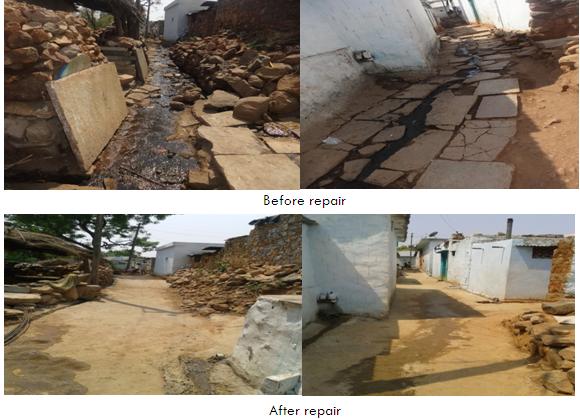The Concern For Children
YFA’s vision strongly advocates the policy focus on children. It if felt that the most vulnerable and poorest of the poor in the society found to be children hence, one can find the high infant mortality rate and also the children are highly susceptible to various health disorders due to their position in the families and society. Seldom the children are involved in any decision making process and highly vulnerable to follow the traditions of the family and norms of the schools. It is the children who suffer the most during any eventuality and disasters and face uncertain future. Therefore, one can see that there are large number of street children, disable children as they could not get proper health support, high amount of dropouts from the schools for supplementing the income of the families and also face psychological and social violence. The various acts and provisions such as JJ (ICPS) acts and more recently the international community advocated the sustainable development goals (SDGs) the goal 4, 5, and 16 to further the interests of the children. Our Government has biggest responsibility to achieve the overall development of the children and YFA strives to achieve those goals through child participation and cooperation of the institutions. One of the strategy adopted to involve the local schools and children for addressing the crucial issues faced by the communities and children. One of the basic activity planned is to involve schools and child parliaments to motivate parents to send their children to the schools instead of sending them to work. In this respect the school teachers and child parliaments have been involved to motivate the children and parents for the purpose. YFA is contemplating to initiate bridge schools and bridge classes so that the children can be given extra support of quality education so that the child can be readmitted in the school education. Similarly, YFA is also assisting the high risk children suffering from various health ailments with a view to save the life of the child and promote a health society where one would not find any infant mortality. The following case study explains that how the schools and child parliaments are involved in promoting health, sanitation and hygiene in the villages.
Child brings change – A strategy of child parliaments in management of water and health
Case Study:
Introduction:
It is observed that the child has capacity to learn new ideas and intensively practice them provided the opportunities given. In the context of rural India the child receives basic education about water and hygiene for the purpose of examinations and seldom use such good knowledge in their personnel life. YFA recognised the potentials of children in achieving outcomes in three important areas: improving access, change behaviour patterns and reduced incidence of water born deceases.
The strategy:
 It was clear that the children can bring change particularly with respect to sanitation practices and behaviouralpatterns of elders to bring desired results of water use and thus positive health impacts on women and children. YFA involved children in preparing water plans and incorporated their views with respect to repair of existing water resources. The children of Pulgacherla village specially stressed on repairing the water structures as they see every day their mothers walk and spend long hours of their time to fetch water. During these consultations the idea of establishing child parliaments was conceived and exclusively aimed at “changing the behaviour of the elders in water use and hygiene practices”. Today most of the project villages have the child parliaments to achieve the results of health and hygiene.
It was clear that the children can bring change particularly with respect to sanitation practices and behaviouralpatterns of elders to bring desired results of water use and thus positive health impacts on women and children. YFA involved children in preparing water plans and incorporated their views with respect to repair of existing water resources. The children of Pulgacherla village specially stressed on repairing the water structures as they see every day their mothers walk and spend long hours of their time to fetch water. During these consultations the idea of establishing child parliaments was conceived and exclusively aimed at “changing the behaviour of the elders in water use and hygiene practices”. Today most of the project villages have the child parliaments to achieve the results of health and hygiene.
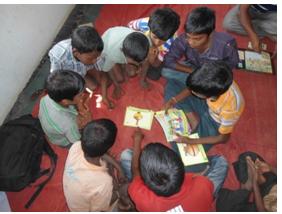 The process:
The process:
Once it was decided to form child parliaments together with the members of SujalSamithis the YFA staff approached the primary and secondary schools in each village to share the idea with children and teachers. The schools have come forward and as a first step conducted rallies, house to house visits and candle walks to create awareness about the following practices.
– Take bath every day
– Wear always washed and dried cloths
– Nails shall be cut and clear, no mud shall be seen inside nail
– Drinking water shall be kept in closed vessels or kept lid on the top to avoid dust falling on it
– Use handled lid to lift water from it for drinking
– Vegetables shall be washed before cutting and cooking
– Hands and legs shall be washed with soap after using toilet
– Before taking food wash hands with soap
– Cooked food shall be kept closed to avoid staying of flies
– Food items shall be kept hot before consuming
– Drinking water shall be boiled and kept cool
– The surroundings of house shall be kept clean and dust free
– Used water shall be taken to the plants by digging a way
– Steps shall be taken not to stay the used water in front of the house
The child committees have also decided to conduct their review meetings including street plays to sensitize the village elders. The children further created decentralised small groups and undertaken door to door campaigns. They further decided to provide a sanitation award to one best household who follows all the best practices.
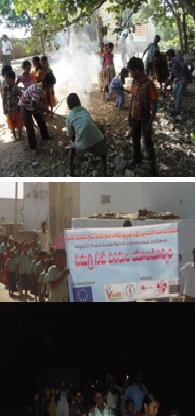 The case of example of implementing the best practices:
The case of example of implementing the best practices:
Pulgacherla a sleepy village of Pangal Mandal of Mahabubnagar district. About 300 families reside in the village and majority of them are illiterate and eakout their living through agriculture and labour. Access to village is by katcha roads and majority of the times reaching village is a challenge. Due to such backwardness many people particularly women and children face health risks due to poor awareness and poor hygiene. YFA staff felt that changing of human behaviour through awareness and knowledge is a perquisite for any development in the village and hence, the staff decided to involve children in the process. Accordingly, the staff identified dynamic children group and constituted a child parliament. Initially the children were given training by the staff and teachers on various messages of best practices which are already the part of their curriculum. The teachers also supported the process and took permission from Mandal Education Officer to involve children to spread the messages of best practices. It is heartening to see the children visiting door to door and conducting candle light campaigns spreading the messages. The decentralised children committees visit cluster of houses and conducts workshops on washing hands, keeping the vessels clean and environment. The children were involved in Shramadan in the villages and many households in the village informed that following the advice from the children the health status of people is getting better. Vallamma a karyakartha of Pulgacherla village says that the children have shown the way for better practices for water and sanitation but the process of changing behaviours may take longer time and the children must have patience and courage to continue the work.
Children, Women and a member of SujalSamiti’sMr.Narsi Reddy brings change- an example of SujalSamit Collaborative action
Rationale:
Community participation in managing water infrastructure and water resources is the basic factor in achieving sustainability. The government through its policy of 2012 emphasizes the need for involvement of people particularly women both in maintenance, distribution and management.
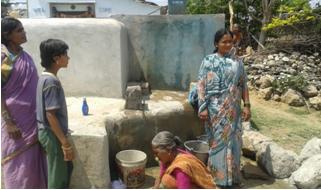 Existing situation in Kanagadda village:
Existing situation in Kanagadda village:
The Kanagadda village located in Sedam Taluk of Gulbarga district this area is particularly known as “Dark Zone” as far as the groundwater is concerned. The village typically situated on highland whereas its agriculture lands on mid and lower lands. Such geographical local geographical conditions makes difficult to get groundwater at appropriate depth. The village has about 500 families and majority of them depend on the traditional open wells for their drinking water needs. The women members of the SujalSamiti raised the demand for renovation of these open wells with respect to raising of its boundary wall and secondly setting up of a water tank with motor and taps. The rationale suggested for the need has the following dimensions:
– The open wells are situated on surface without any boundary
– The surface open wells were contaminated including rain water freely flowing irrespective of the season
– In the past human and animals slip into wells as there was no boundary
– Women had to use rope and bucket to pull the water resulted in drudgery and human insecurity.
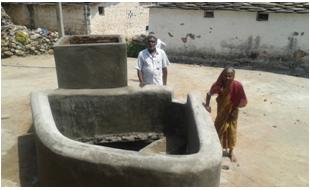
The approach:
Based on their request YFA initiated an appraisal of costs involved, sharing of costs and technology. The appraisal estimated the cost for boundary wall the total expenditure will around Rs.75000 for two wells which includes motor, a syntax tank, pipeline and taps. This was beyond the capacity of the local people and YFA. At this stage Mr.Narsi Reddy the member of the Sujalsamiti in one of the meetings suggested for a simple technology which can reduce the cost of about 40%. He suggested for a thinner boundary walls and in one of the location of the boundary wall construct a storage water tank. In this way one need not buy an expensive syntax tank from the market and also invest resource for its transportation. The sujal samite member then requested Narsi Reddy to initiate and superwise the construction. At the end of the year Narsi Reddy could construct the boundary wall including storage tank and linked to pipes, motor and tank.
The change:
Today the water tank stores about 500 liters of water which is sufficient for 5-8 households at a stretch and later turn by turn the tank is filled based on the need and the water is filled by taps fixed and the women can take it to home. The well laid platform serves as multiple use for women cleaning / washing cloths and sometimes acts as women’s meeting point and could bring enough leisure time for the women. When YFA team asked the women of the Sujal samite many of them had to say the following:
– Today they get clean access to water at their convenience
– No human and animal loss including zero contamination
– Reduced drudgery and physical pain
– Multiple use of water and enhanced leisure time
The Lessons Learned:
The community participatory process resulted in reduced cost of the programme and the activity is completed within Rs.26000/- . The involvement of people assured the transparent implementation of women’s demand otherwise there could be more human and health risks of the people. The local technology as demonstrated found to be acceptable by people and hence, the sharing of resources could be achieved. The social capital in a form of collective action undertaken through Sujalsamiti for managing their traditional water system constitutes a form of social capital that can have spinoff effects in other aspects of social and economic life. The skills the Sujalsamiti learned through their experience with the well work in Budgeting, implementing and organizing constitute a set of knowledge that can be used in many other productive endovers.
Efficiency:
The case of Kanagadda village depicts an example of efficiency for water management in decentralized manner. Given the opportunity the local technology found to be strong incentive to manage the water infrastructure and water resource.
Child parliament, sujalsamiti and women of Madepally shows the way for Swatch Bharat.
Madepally is a type-A village adopted for intensive work by the consortium. The village has extremely strong sangha and dynamic women karyakarthas. In the past, these women karyakarthas have initiated a clean village programme clearing manure plots and debris near the village entrance and school. The idea of cleaning the village came from the sangha as many of their children and elders suffered with Elephantiasis and other respiratory ailments. Self and YFA motivation resulted in women collectively started clearing the debris even though they had to face stiff resistance from the households who created manuring pits. However, after a long struggle and voluntary labour today the school area is totally cleaned. Taking a lead from their experience, the women of sangha and sujalsamiti and children vowed to clean their village and achieve total sanitation of the village. Their motivation was supported by the on-going Swatch Bharat mission and hence panchayat was totally supportive to the activity. A Budget was prepared by the SujalSamiti for linking the pipes with household toilets and kitchen, additional materials for drain work and needed cleaning materials. The Budget was about Rs.22000/- and the responsibility of raising resources was given to SujalSamiti and child parliament. The child parliament was particularly worked to visit door to door to raise donations for the purpose and together with SujalSamiti they could raise about Rs.7000/- and YFA supported Rs.15000/- for purchase of materials. Today the women like Chandramma and others feel proud to show their work to achieve total cleanliness of the village.
